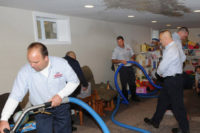FARGO, N.D. – March 25, 2009 (AP) – Volunteers and government teams threw everything they could Tuesday into the fight against the rising Red River as the water rose 5 feet in a day on its way to possible record flooding.
The city was even getting a portable wall system that shielded troops in Iraq and Afghanistan from bullets.
"I think it's going to be a lifesaver," Al Weigel, Fargo's director of operations, said Monday of the wall system.
Across the river in neighboring Moorhead, Minn., Mayor Mark Voxland said the projected arrival of the crest in the area had been moved up to Thursday afternoon. He said the National Weather Service expects a crest in the range of 41 feet to 41.5 feet, which would top the record of 39.6 feet set in the devastating 1997 flood.
Voxland estimated 70 percent of the needed sandbags are already in place.
Flood stage is 18 feet. The river was just below major flood stage of 30 feet Tuesday morning, up from 25 feet on Monday morning, the weather service said.
An emergency dike to protect downtown Fargo was being raised to 42 feet, but the expected crest would threaten several neighborhoods and hundreds of homes in lower areas.
Upstream, the flood crest on the north-flowing Red was expected to arrive Wednesday morning at Wahpeton and its cross-river neighbor Breckenridge, Minn., at 18 feet - about two feet lower than initially thought. Flood stage there is 10 feet and the record is 19.4 feet, set in 1997. City officials said they were holding their own.
High school and college students were let out of class Monday to help with sandbagging. City officials planned to fill more than 1 million sandbags, but with more rain forecast they increased the need to nearly 2 million sandbags - about 500,000 each day by the end of the week.
The portable wall system is made up of 3- and 4-foot-high interlocking containers with heavy steel frames covered by high-tech material. It took workers just half an hour Monday to set up about 1,000 feet of the containers that are then filled with sand.
"They are unbelievably quick," Weigel said. "Any doubts you may have about it are gone when you see the amount of sand that it holds. It's a nice system."
The system was designed for erosion control, but quickly became a popular product for the military, said Stephanie Victory, a spokeswoman for the company, Hesco Bastion. Its first meaningful test for flood protection came last summer in Iowa, she said.
One of the hotspots is Oakport Township north of Moorhead, where residents were evacuated by boat during the Red River flood of 1997. Homeowner Barb Groth was helping volunteers fill sandbags near her home in Oakport on Monday morning.
"We're considered the dry side of the township, but we flooded anyway in 1997. This flood is supposed to be worse," Groth said. "We're nervous."
The city of Fargo was operating three large machines capable of producing 15,000 sandbags an hour. Sand was also being piled on the floor of the Fargodome for people to shovel into bags the old-fashioned way.
The Minnesota National Guard was sending more than 300 soldiers to the Red River Valley to help with the flood fight, and the North Dakota Guard said about 500 members were ready.
While eastern North Dakota residents battled the Red River, people in ranching and farming country to the west fought the sudden rise of other streams swollen by melting snow and rain.
It took a National Guard helicopter to rescue Bernie and Jenny Martin when a creek around their farm near Carson rose faster than expected.
"We were on an island. We were totally surrounded by water," Bernie Martin said by phone from a friend's home. Guard members used the helicopter because they were worried a boat would hit floating ice chunks or strong current.
At Linton, south of Bismarck, a rising creek forced the evacuation of about 75 homes, and about 10 people were rescued by boat.
Most of the 2,500 residents of Hazen, northwest of Bismarck, were filling sandbags Monday to fight the rising Knife River. Officials said five homes and the city's golf course were flooded. The water was nearly 6 feet higher than the flood stage of 21 feet, said Una Reinhardt, of the city's water department.
Red River rises 5 feet in day; record flood possible



